|
|
|
Sort Order |
|
|
|
Items / Page
|
|
|
|
|
|
|
| Srl | Item |
| 1 |
ID:
139028
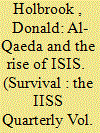

|
|
|
|
|
| Summary/Abstract |
Ayman al-Zawahiri’s leadership of al-Qaeda has been beset by a series of calamities that threaten the viability of the movement’s core group and its legacy. Zawahiri was always more suited to be second in command, offering dense strategic and ideological deliberations rather than acting as the public face of a global Islamist militant movement. Replacing the charismatic Osama bin Laden was thus always going to be a challenge. The fact that secular Arab rulers, especially in Egypt (Zawahiri’s native land and a consistent preoccupation of his), have been toppled on his watch through popular uprising and military intervention – as opposed to jihadist coercion – has further undermined Zawahiri’s position as al-Qaeda leader. The Arab Spring uprisings demonstrated the success of regime-change methods that al-Qaeda had consistently dismissed, while removing some of the main protagonists of its grievance narrative.
|
|
|
|
|
|
|
|
|
|
|
|
|
|
|
|
| 2 |
ID:
162063
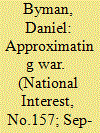

|
|
|
| 3 |
ID:
164592
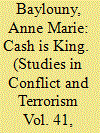

|
|
|
|
|
| Summary/Abstract |
The role of resources in war has been much debated. What happens when foreign patrons provide lavish amounts of cash to rebels, without mechanisms of accountability? This article analyzes three major sources of funding and their micro-level effects on insurgent-groups in the Syrian civil war. Recipients of funding demonstrated opportunism in actions, alliances, and ideologies, directly related to the funding source. Funders thus set the agenda of the war, promoting Islamist ideologies and regional over local issues. Private donors rivaled state sponsors, in what may be a harbinger of future globalization trends.
|
|
|
|
|
|
|
|
|
|
|
|
|
|
|
|
| 4 |
ID:
156019
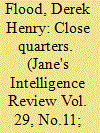

|
|
|
| 5 |
ID:
142967
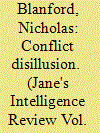

|
|
|
| 6 |
ID:
139024
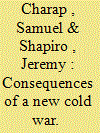

|
|
|
|
|
| Summary/Abstract |
The Ukraine crisis poses vexing policy challenges for Washington. President Barack Obama has sought to strike a balance between the imperative of responding to Russian actions and the equally important need to avoid an all-out confrontation with Moscow. As he put it in July 2014, ‘it’s not a new Cold War … [It] is a very specific issue related to Russia’s unwillingness to recognise that Ukraine can chart its own path.’ The problem is that the administration’s balancing act cannot last long. As the deterioration of conditions in Ukraine in recent weeks has demonstrated, forces beyond the president’s control are pushing him toward the very new Cold War that he wants to avoid. He will eventually face a choice between that outcome, which would be hugely dangerous and costly, and negotiations on a revised regional order in Europe, which might hurt him politically but would be far better for the United States and for the world. He should move toward the negotiated outcome now.
|
|
|
|
|
|
|
|
|
|
|
|
|
|
|
|
| 7 |
ID:
170055
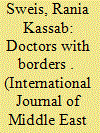

|
|
|
|
|
| Summary/Abstract |
In humanitarian studies, it is typically the white western doctor who stands apart as the cultural prototype or universal figure through which global aid is delivered to vulnerable groups. This article, by contrast, examines the experiences of members of a prominent Syrian-American global medical aid organization. The members of this organization provide life-saving emergency care to millions of Syrians affected by the ongoing civil war, both inside Syria and in surrounding refugee camps. Drawing on over four years (2014–18) of intermittent interviews and observations with these doctors, I suggest that they are positioned precariously within a global “hierarchy of humanitarians” that deems their lives less worthy of mobility and protection than others. In critically analyzing the unequal politics of humanitarianism that exists around the Syrian war, this research complicates our understandings of the givers of global aid, as well as the medical humanitarian encounter itself in times of war.
|
|
|
|
|
|
|
|
|
|
|
|
|
|
|
|
| 8 |
ID:
179857
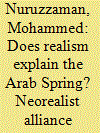

|
|
|
|
|
| Summary/Abstract |
Dominant International Relations theories—realism/neorealism, liberalism/neoliberalism, and constructivism—have so far developed no rigorous theoretical attempts to interpret the Arab Spring, though some marginal efforts have been made to critique the failure of realism to interpret this historical development. This article presents a neorealist interpretation of the Arab Spring focusing on the Syrian civil war, where conflicts between the pro- and anti-status quo forces have unfolded in alignments and counter-alignments centering around rival domestic and external groups. To explain the involvements of rival alliances in the post-2011 Syrian conflict, namely, the United States–Saudi Arabia–Israel alliance and the Russia–Iran–Syria alliance, this analysis employs neorealist theories of alliance formation—the balance of power and balance of threat theories—as articulated by Kenneth Waltz and Stephen Walt, respectively. The dynamics of these formations in Syria lend more support to Walt’s theory that states balance against threats rather than against power. The complex nature and dynamics of the Syrian war, however, calls for refinements of Walt’s balance of threat theory. Accordingly, the article also explores various refinements of Walt’s theory to better explain future complex civil wars involving highly polarized domestic and external parties.
|
|
|
|
|
|
|
|
|
|
|
|
|
|
|
|
| 9 |
ID:
171678
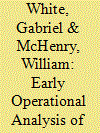

|
|
|
|
|
| Summary/Abstract |
On 30 September 2015, Russian military forces began their overt involvement in the then-four-year-old Syrian Civil War; the subsequent Russian air campaign and political support to the Assad regime are now well documented. However, Russia’s material military support remains largely understudied. This article explores one line of material supported with a demonstrated impact on Syrian Arab Army military operations, as well as Russia’s use of Syria as a sandbox for promoting its defense industry. This article seeks to analyze the deployment, impact, and use of half a dozen T-90A main battle tanks provided to Syrian government forces and their allies in November 2015. It argues that the provision of this weapon played a role in the regime’s significant victories on the battlefield — and assesses their impact on the battle of Aleppo (19 July 2012–22 December 2016). Its performance on the battlefield likely served as a positive showcase for the platform, which contributed to a series of considerable arms deals of the platform to states across the Middle East and South and East Asia. Finally, our research demonstrates the extent to which this platform was utilized by various pro-regime proxy forces in Syria, including those closely linked to the Islamic Revolutionary Guard Corps (IRGC).
|
|
|
|
|
|
|
|
|
|
|
|
|
|
|
|
| 10 |
ID:
191058
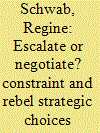

|
|
|
|
|
| Summary/Abstract |
Theories of interaction among rebel groups in civil wars, like other works in the armed conflict literature, continue to see force as foundational to the trajectory and outcome of conflict. But evidence from inter-rebel conflicts in the Syrian war, which has been one of the major civil wars of our times, shows that military force is not always the preferred tool even in situations where violence is presumably cheap: in conflicts between dominant rebel groups and weaker rivals. Rather than using force, Jabhat al-Nusra, one of the strongest groups in the Syrian conflict, frequently chose to negotiate with rivals. Existing theories of inter-rebel conflict fail to explain such variation in responses. As an explanation of this puzzle of non-force, I argue that the constraint emanating from the conflict with the main enemy determines rebels’ strategies towards rivals. To investigate this argument, the paper draws on the triangulation of original data on inter-rebel conflicts in Syria, encompassing written agreements between Jabhat al-Nusra and other rebel groups, a database of important military operations in the Syrian civil war since 2011, and interviews with civil and military participants in the insurgency. The findings have important implications not only for our understanding of inter-rebel dynamics in the Syrian conflict but also for other complex civil wars concerning the relationship between inter-rebel negotiation, cooperation, success, and war duration.
|
|
|
|
|
|
|
|
|
|
|
|
|
|
|
|
| 11 |
ID:
129516


|
|
|
| 12 |
ID:
146348
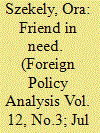

|
|
|
|
|
| Summary/Abstract |
When a regional sponsor of militant movements experiences profound domestic instability, what happens to its clients? This paper explores this question by examining the case of Syria and its clients using a principal–agent approach. It examines three types of principal—single, collective, and multiple—focusing on the varying effects that these relationships have on the agents involved and arguing that each type of principal presents prospective agents with a trade-off between a loss of autonomy and a loss of internal cohesion. By comparing the effects of Syrian sponsorship on nonstate actors who have served as Syrian agents at various points in the evolution of the regime, I demonstrate that each type of principal has distinct advantages and risks for its agents. The paper concludes by outlining five possible outcomes of the current uprising in Syria for the Asad regime's clients, based on the uprising's impact on the regime as a principal.
|
|
|
|
|
|
|
|
|
|
|
|
|
|
|
|
| 13 |
ID:
163253
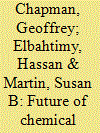

|
|
|
|
|
| Summary/Abstract |
With chemical weapons (CW) use in Syria raising questions about the health of the CW norm, this article analyzes whether the Syrian case will lead to further proliferation and use of chemical weapons by states. We examine the use of chemical weapons at Ghouta in 2013 and on the Hama Plains in 2014 and find that: first, chemical weapons have demonstrated limited military utility in Syria, either tactically or as a tool of civilian victimization; second, the costs of use have been repeatedly demonstrated by the international reaction to their use; and third, the use of sarin—a nerve agent—has attracted a stronger international response than the use of chlorine, a less lethal agent. Consequently, we conclude that the Syrian case is unlikely to lead to significant proliferation and use of chemical weapons; any that does occur is most likely to involve states already outside the CW norm.
|
|
|
|
|
|
|
|
|
|
|
|
|
|
|
|
| 14 |
ID:
143164
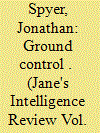

|
|
|
| 15 |
ID:
154171
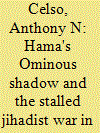

|
|
|
|
|
| Summary/Abstract |
Little has been written about the Syrian Civil War and its relationship to the 1980s revolutionary period. This essay examines this historical connection and emphasizes the unique features that drive the current rebellion. The essay has five sections. First, it lays out the historical roots of the current confessional-political conflict. Second, it provides an overview of the Muslim Brotherhood – led 1979 – 82 rebellion and its defeat in Hama. Third, it discusses the role that the Muslim Brotherhood revolt plays in the current conflict. Fourth, it analyzes jihadist infighting that has weakened the insurgency. Finally, it assesses the role that Russian, Iranian, and Hezbollah intervention has had in bolstering the regime of Bashar al-Assad. Syria's jihadist revolt has limited but important parallels to the failed 1982 Muslim Brotherhood insurrection. Even with the regime's conquest of Aleppo, the Islamist defeat in today's war is far from certain, although the current jihadist insurgency has stalled.
|
|
|
|
|
|
|
|
|
|
|
|
|
|
|
|
| 16 |
ID:
154321
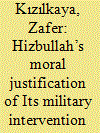

|
|
|
|
|
| Summary/Abstract |
Intervening in the Syrian Civil War was a significant decision by Hizbullah’s leadership, carrying as it did the risk of losing public support in the Arab street. This article argues that Hizbullah used highly moralized rhetoric to justify its involvement in the Syrian conflict, emphasizing ethical necessity rather than self-interest. The article offers a descriptive analysis of Hizbullah’s justifications and compares them with major intellectual traditions on the ethics of war. The findings suggest that Hizbullah has been adept at developing a strategy for legitimizing its armed engagement outside Lebanese territory.
|
|
|
|
|
|
|
|
|
|
|
|
|
|
|
|
| 17 |
ID:
184738
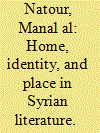

|
|
|
|
|
| Summary/Abstract |
This study explores the juncture of home, liminality and counternarrative in contemporary Syrian literature produced after the eruption of the revolution in 2011. As a case study, I examine how Maha Hassan’s Drums of Love and Ghassan Jubbaʿi’s Qahwat Al-General redefine the concept of home through heterotopic and utopic representations of the place. The study demonstrates that in both works a real sense of home proves unattainable. When the protagonists seek a place for themselves in a home that enjoys freedom and justice, the home denies them. Utilising Bakhtin’s notion of polyphony, I investigate how both works represent a multiplicity of oppressed voices in a ‘home’ that imprisons and estranges everyone. Both texts bear global messages, inviting their readers to examine the complexity of the status quo in Syria through subjecting all-encompassing representations of the revolution and resisting oppression to a process of contestation. Finally, I argue that the unattainable sense of home depicted in the novels marks such texts as a part of the enduring legacy of the Syrian revolution and its causes, and thereby they may foreground solidarity among Syrians who continue to suffer the loss of home.
|
|
|
|
|
|
|
|
|
|
|
|
|
|
|
|
| 18 |
ID:
186314
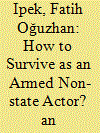

|
|
|
|
|
| Summary/Abstract |
This article examines the case of the Syrian Democratic Union Party (Partiya Yekîtiya Demokrat or PYD) to explain the survival strategies of the non-state armed actor (NSAA). Although the Middle Eastern State System remarkably remained stable after the end of Mandates, the legitimacy of states has been eroded by a combination of colonial legacy, neo-patrimonialism, and authoritarianism, laying the seeds for the rise of non-state challengers to states. At the beginning of the Syrian uprising, the PYD did not fight against the Syrian regime but established its autonomy in northern Syria by taking advantage of the chaos. Using the process-tracing method, the article explains the survival of the PYD until the territorial defeat of the so-called Islamic State and offers parameters of the territorial logic, its organizational structuring, and relations with the states to explain the survival strategies of the PYD. Finally, the study concludes that while the territorial and organizational structuring logics of the NSAA shape its strategies, its complex relationship with states determines its survival.
|
|
|
|
|
|
|
|
|
|
|
|
|
|
|
|
| 19 |
ID:
153883
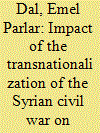

|
|
|
|
|
| Summary/Abstract |
This article examines how Turkey was affected by the conflict spillover effects of the Syrian civil war and its escalation in the last two years with the rise of the Islamic State in Iraq and Syria (ISIS) threat and the changing nature of the Kurdish insurgency. It seeks to assess the degree of the transnationalization of the Syrian civil war and its spread to Turkey by employing a theoretical framework borrowed from the conflict clustering literature. The first part will introduce the dual-embedded theoretical framework with its division of conflict spillover effects as “intentional” and “unintentional”. The second part tries to apply this dual-track framework to the Turkish case and, thus, seeks to test the conflict spillover factors on Turkey. The third part focuses on the two specific and major spillovers of the Syrian civil war, the ISIS threat and the rise of an embedded Kurdish insurgency, namely Democratic Union Party (PYD or Partiya Yekîtiya Demokrat)-Peoples Protection Units (Yekîneyên Parastina Gel or YPG)/Kurdistan Workers Party (Partiya Karkerên Kurdistanê or PKK), and explains the conflict spillover processes of these two case studies under a triple framework, origin, diffusion and escalation and with reference to the division between intentional and unintentional spillover effects.
|
|
|
|
|
|
|
|
|
|
|
|
|
|
|
|
| 20 |
ID:
188004
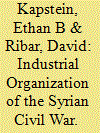

|
|
|
|
|
| Summary/Abstract |
The Syrian Civil War represents an extreme outlier in terms of the number of insurgent groups which have been engaged in the fighting. These groups have also been remarkably persistent over time, partly due to the fact that rebel in-fighting has been relatively contained. They have also targeted civilians far less than the Syrian Army. These stylized facts run counter to much of the existing literature on multi-party civil wars, which has emphasized the influence of the balance of power on group dynamics. In this article we instead draw upon balance of threat theory, along with insights from the economics of industrial organization, to understand insurgent behavior in the Syrian Civil War, based on a newly compiled dataset of rebel violence. Our research suggests that conflict scholars need to account for factors beyond the balance of power if they are to adequately explain inter-rebel dynamics.
|
|
|
|
|
|
|
|
|
|
|
|
|
|
|
|
|
|
|
|
|